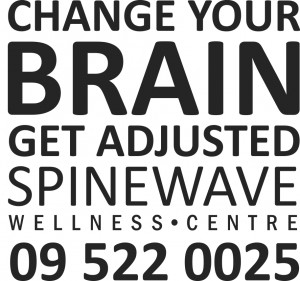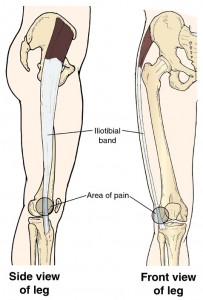 The iliotibial band is a common source of perceived back, hip and groin pain. While people often associate iliotibial band (ITB) syndrome with runners, it’s a frequent occurrence amongst those who don’t run too.
The iliotibial band is a common source of perceived back, hip and groin pain. While people often associate iliotibial band (ITB) syndrome with runners, it’s a frequent occurrence amongst those who don’t run too.
The ITB is a strong, thick band of fibrous tissue that runs along the outside of the leg. It starts at the hip and runs along the outer thigh and attaches to the outside edge of the shin bone (tibia) just below the knee joint.
Low back and hip pain can be challenging to diagnose because there are multiple sources of pain referral and with the way pain receptors are wired in the low back (being wide apart) a person cannot always accurately perceive where the source of the pain is, although they might feel it in their hip or groin.
The old understanding is that the ITB becomes inflamed as it runs over the leg bone due to friction. This doesn’t really happen because the ITB itself is extremely rigid and resistant to stretch – it lengthens less than 0.2 percent with a maximum voluntary contraction.
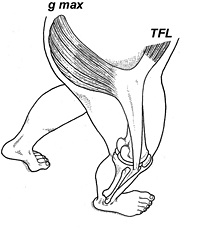 The role of the ITB is to flex, lift sideways and internally rotate the leg. It’s fibrous tissue splits into two parts at the top of the hip: 1. Melding with the gluteal muscles at the back (g max) and 2. Joining the tensor fasciae latae muscle at the front (TFL).
The role of the ITB is to flex, lift sideways and internally rotate the leg. It’s fibrous tissue splits into two parts at the top of the hip: 1. Melding with the gluteal muscles at the back (g max) and 2. Joining the tensor fasciae latae muscle at the front (TFL).
Tension and compression of the ITB occurs when these two connections at the top of the band become weak or don’t have appropriate nerve firing from spine and brain.
Weakening of the gluteal muscles can happen in a number of ways: Sitting for long periods of time, crossing legs, or standing with hip cocked to one side. Gluteal muscles also weaken through physiological and mental stress. Parts of the nervous system responsible for handling stress weaken the body’s posture and the pelvis can lose strength and form. See weak hip abductors (B) versus normal hip abductors (A). This problem can refer or create low back pain, hip pain, or groin pain.
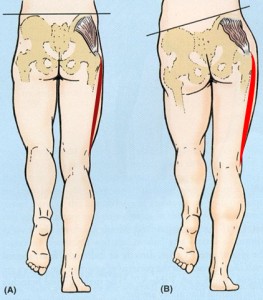 Correcting this functional problem requires more than simply icing or rubbing the ITB, since no friction actually occurs to create inflammation. Spinal adjustments to the low back, opposite sacroiliac joint and neck are important in reversing the gluteal weakness as new research now shows that chiropractic care increases strength, prevents fatigue and improves cortical (brain) drive to these leg muscles.
Correcting this functional problem requires more than simply icing or rubbing the ITB, since no friction actually occurs to create inflammation. Spinal adjustments to the low back, opposite sacroiliac joint and neck are important in reversing the gluteal weakness as new research now shows that chiropractic care increases strength, prevents fatigue and improves cortical (brain) drive to these leg muscles.
Strengthening of the gluteal muscles should follow chiropractic adjustments, then stretch daily: upper gluteus maximus (A, pull up and across, also done lying flat) and tensor fascia latae (B, C). For more stretches, click here.
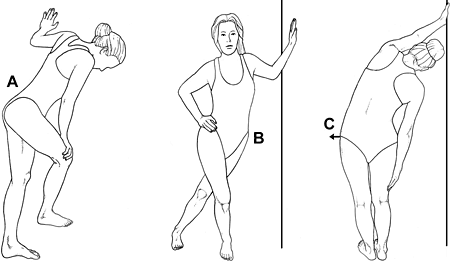
Having been a converted fan of chiropractic care now approaching the 15 year mark, I am thrilled to recommend the exceedingly high level of service and care experienced at Spinewave Wellness Centre in Remuera Road, Auckland.
In my view, both Pip and Neil deliver a professional, efficient and caring approach to chiropractic care, making the whole experience feel like their clients are “in great hands.”
I recently approached Neil, complaining of a number of specific low back symptoms. He swiftly diagnosed the problem as ITB or iliotibial band syndrome and within minutes Pip had a printed article on the most up to date research on the topic, with Neil providing a range of remedial stretches.
I am so grateful that these stretches are relieving the pain associated to ITB syndrome and are providing opportunities for greater flexibility and movement.
Thank you both so much.
James Mayhew
© Dr Neil Bossenger 2013

